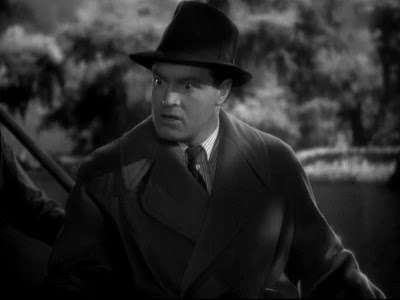I've posted reviews of horror movies (and the occasional splattery action movie, western, sci-fi movie, suspense thriller, and underground/gross-out comedy) on this site since 2007, but this week we have a first — a Bob Hope movie. No, I'm not talking about Fancy Pants, friends. I'm talking about the fourth filmed adaptation of the hit horror/comedy play The Cat and the Canary. I reviewed the first adaptation, from German Expressionist master Paul Leni, back in 2016. Check it out here.
Hollywood pro Elliott Nugent closely follows Leni's template, and both movies are well-paced and successful at keeping the horror and comedy elements from stepping on each other. Nugent is a craftsman where Leni was an artist with vision, and the former's Expressionist style has been replaced with a slicker classic Hollywood look, but both visual approaches work well with the material.
Otherwise following the story closely (though changing most of the character's names), Nugent's version makes a couple of big changes to Leni's film and the play. The setting has been moved from a large Gothic castle in New York near the Hudson River to a hidden old mansion in the Louisiana bayou near New Orleans. The film also reduces the time between the death of Cyrus West and the reading of his will from twenty years to ten. This makes a bit more sense, considering most of the relatives are so young.
To recap the story, eccentric millionaire Cyrus West lived a life of family-avoiding isolation in the bayou, sharing the home with his housekeeper Miss Lu (Gale Sondergaard) and her black cat. His will, drawn by his attorney Crosby (George Zucco), stipulates that his living relatives must journey to his bayou home on the tenth anniversary of his death to hear the reading. Miss Lu is allowed to remain in the home for that decade.
On that auspicious date, the mostly distant relatives make the trek by Native American-guided canoe through the alligator-filled swamp. The survivors include elderly Aunt Susan (Elizabeth Patterson), middle-aged Cicily (Nydia Westman), and four young people, the hotheaded Fred (John Beal), the unctuous Charlie (Douglass Montgomery), the lovely Joyce (Paulette Goddard), and theater actor and radio star Wally (Bob Hope). I'm very unclear about bloodlines and who's related to who (and how), especially because all three young men want to get with Joyce. Charlie even used to date her and wants to get back together, which enrages Fred, who was already pissed off from the jump. Fred and Charlie are both suspicious of Wally, but Wally has the edge on both of them by simply not being a creep. Aren't you all related to each other? What gives? (The silent film did a much better job of noting how distantly removed the relations were.)
Guests assembled, Crosby opens the first of two envelopes (three, if you count the hidden envelope later in the film). Joyce inherits the entire fortune, but there's a catch. She must stay alive and maintain her sanity for thirty days, or the fortune and estate go to a different relative, concealed in the second envelope. A few of the others point out the incentive this gives them to kill Joyce or attempt to make her insane.
In the midst of all this hubbub, someone fires shots outside. The mysterious armed man comes to the door and announces himself as a guard at the nearby mental institution. A violent inmate has escaped. Nicknamed The Cat, this escapee is a murderer with shaggy hair and long gnarled fingers with long fingernails who crawls like a cat when he's about to attack. (His fellow prisoners really need more imagination when coming up with nicknames.) He's been spotted near the mansion. Meanwhile, Miss Lu is lurking about, acting strangely, and delivering cryptic pronouncements. The stage is set for mirth, murder, mayhem, family drama, and comic hijinks.
Hope, Patterson, and Westman deliver the comic relief in between the drama and the scares (there's a running gag where Westman stops screaming if you put a finger under her nose). I've never been a big Bob Hope fan, but I am a big Albert Brooks fan, and I was delighted to see some seeds of Brooks' delivery and timing in what Hope does in this film. Nothing here is knee-slappingly funny, but the humor is brisk and pleasant and doesn't wear out its welcome, and Hope and Goddard have real chemistry (so much so that they were teamed up for another horror/comedy, The Ghost Breakers, the following year).
The horror elements are handled effectively. Even though I knew most of what was coming, having seen the 1927 film, I was still excited by the dark twists and turns and their execution. Nugent captures an atmosphere of real dread, despite all the comedic biz, and the finale is genuinely creepy.
I don't have a lot of fancy-pants analysis to deliver this time. This is a solid Hollywood movie, well-made and skillfully performed, and I had a good time. It had been long enough since my viewing of the silent version that I was able to kick back and relax into this one without it feeling repetitive. I give this version three cats and two and a half canaries. Nugent is no Paul Leni, but he knows how to make a quality movie.


















.jpg)



